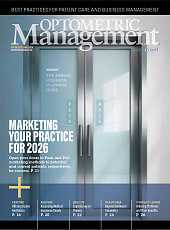WHILE MULTIFOCAL contact lenses have been on the market for decades, the application of multifocal (MF) contact lenses for patients remains largely underutilized (12%) among practitioners (Dumbleton and Palombi, 2022). Merely 1% of all multifocal lenses prescribed in the US were rigid GP lenses (Nichols and Fisher, 2023).
Common barriers to wider acceptance of rigid MF lenses may include, but are not limited to, a lack of clinical confidence or knowledge of the latest developments in the MF contact lens industry, the risk of patient rejection, and the concerns about losing chair time.

Intuitively, soft MF lenses seem to be the most common type of lenses available for presbyopic patients. Nevertheless, for patients who have irregular corneas or astigmatism, or high or out-of-range prescriptions, rigid MF lenses may offer the best visual outcomes. In fact, more than 75% of patients who have astigmatism as low as 0.75 D favored the quality of vision they gained with rigid GPs over soft MFs (Michaud et al, 2018).
When selecting an appropriate rigid MF lens design for patients, it is important to understand the intricate relationship between the lens characteristics and the patient’s on-eye lens performance to guide the selection process. Think of why you want to prescribe MF lenses in the first place. The two common scenarios are for presbyopia and, more recently, myopia management for children and teens.
Pupil size can play a vital role in varying illumination levels, thereby serving uniquely different visual needs. As expected, pupil size generally decreases with aging (Winn et al, 1994). Visual complaints can result from pupil-related dysphotopsia (Wolffsohn and Davies, 2019). So, selecting an MF lens design with a relatively small distance-centered zone helps create an increased depth of focus and better visual performance at distance for presbyopic patients.
Interestingly, while higher-order aberrations (HOAs) tend to increase with aging, the impact of HOAs is generally attenuated in patients who have smaller pupil sizes (Zheleznyak et al, 2014). HOA correction remains largely controversial in this patient population, subject to various theories of optical aberrations associated with zonal decentration of MF lens designs (Plainis et al, 2013; Jang et al, 2024).
Prescribing MF lenses for myopia management may not simply be about clarity after all. Despite the theory that peripheral defocus is the impetus in slowing axial elongation, the Bifocal Lenses In Nearsighted Kids (BLINK) study noted that mitigation of axial elongation generated by a higher peripheral add (+2.50) MF lens design was more likely attributed to the lens type than to peripheral defocus signal (Berntsen et al, 2023). Surprisingly, pupil size was found to have little influence in axial length growth when using the same peripheral +2.50 add power (Berntsen et al, 2023). This suggests that the field of myopia management encompasses much more intricacy and complexity than was previously known.
Echoing the theme of this year’s Global Specialty Lens Symposium (“It’s Getting Personal: Customized Contact Lens Care”), practitioners have an opportunity to tailor vision for patients at a deeper personal level, particularly for those who have complex corneas or unique visual demands. Indeed, fitting specialty contact lenses via both “prescription-driven” and “cornea-driven” perspectives supported by sophisticated technology can improve the visual outcomes of these special patients.
References
1. Dumbleton K, Palombi J. Soft multifocal contact lenses: a review. Contact Lens Spectrum. 2022;37(6):34-38,40. clspectrum.com/issues/2022/june/soft-multifocal-contact-lenses-a-review
2. Nichols JJ, Fisher D. Contact lenses 2022. Contact Lens Spectrum. 2023;38(1):20-22,24-26. clspectrum.com/issues/2023/january/contact-lenses-2022
3. Michaud L, Bennett ES, Woo SL, et al. Clinical evaluation of large diameter rigid-gas permeable versus soft toric contact lenses for the correction of refractive astigmatism: a multi-center study. Eye Cont Lens. 2018;44(3):164-169. doi: 10.1097/ICL.0000000000000323
4. Winn B, Whitaker D, Elliott DB, Phillips NJ. Factors affecting light-adapted pupil size in normal human subjects. Invest Ophthalmol Vis Sci. 1994;35(3):1132-1137.
5. Wolffsohn JS, Davies LN. Presbyopia: Effectiveness of correction strategies. Prog Retin Eye Res. 2019;68:124-143. doi:10.1016/j.preteyeres.2018.09.004
6. Zheleznyak L, Jung H, Yoon G. Impact of pupil transmission apodization on presbyopic through-focus visual performance with spherical aberration. Invest Ophthalmol Vis Sci. 2014;55(1):70-77. doi:10.1167/iovs.13-13107
7. Plainis S, Ntzilepis G, Atchison DA, Charman WN. Through-focus performance with multifocal contact lenses: effect of binocularity, pupil diameter and inherent ocular aberrations. Ophthalmic Physiol Opt. 2013 Jan;33(1):42-50. doi: 10.1111/opo.12004
8. Jang HS, Lee KJ. Spherical Aberration Changes in Patients With Early Presbyopia Wearing Aspheric Multifocal Soft Contact Lenses in South Korea. Eye Contact Lens. 2024 Nov 1;50(11):475-481. doi: 10.1097/ICL.0000000000001120
9. Berntsen DA, Ticak A, Sinnott LT, et al; BLINK Study Group. Peripheral defocus, pupil size, and axial eye growth in children wearing soft multifocal contact lenses in the BLINK Study. Invest Ophthalmol Vis Sci. 2023 Nov 1;64(14):3. doi: 10.1167/iovs.64.14.3



